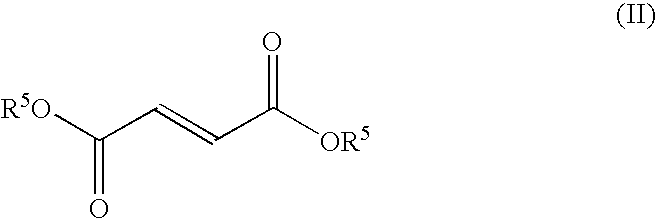Hydrogen sulfide abatement in molten sulfur
a technology of hydrogen sulfide and abatement, which is applied in the field of chemical methods for scavenging hydrogen sulfide (h2s) from molten sulfur, can solve the problems of many environmental and safety hazards, many workers' challenges, and many hydrogen sulfide in turn,
- Summary
- Abstract
- Description
- Claims
- Application Information
AI Technical Summary
Benefits of technology
Problems solved by technology
Method used
Image
Examples
examples 1-12
[0034]A number of potential scavenging agents were screened. Each Example used a 1-liter metal can containing approximately 500 ml of liquid sulfur from a sulfur unit in Louisiana. A modified ASTM D 5705-95 vapor phase test was used at a test temperature of 300° F. (149° C.). Samples were dosed by weight, for instance, 500 ppm is 662 mg in 1324 grams of sample. All additives were used neat out of their original sample containers. It is noted that the can for blank Example 1 was tested for H2S in the vapor space above the sulfur before heating. The results were a starting H2S reading taken of solid can vapor space before the test began of >70,000 ppm. The results are shown in Table 1.
[0035]
TABLE 1First Test Series, Samples Dosed at 500 ppmCan6 Hours22 HoursEx.Scavenging AgentweightH2S ppmH2S ppm1Blank - no additive1484 g>70,000>70,00022 Ethylhexylglycidyl Ether1536 g>70,000Not taken3Epoxidized Methyl Soyate1324 g 39,000 23,000VikoFlex 70104Epoxidized Methyl Linseedate1380 g 52,000...
examples 13-20
[0039]The next series of Examples was conducted similarly to Examples 1-12. The cans were dosed while the samples were at room temperature. The samples were heated to 300° F. (149° C.), then shaken 50 times before the H2S readings were taken. Good mixing was achieved. The results are shown in Table 2.
[0040]
TABLE 2Second Test Series, Samples Dosed as IndicatedCan6 Hours24 HoursEx.Scavenging AgentweightH2S ppmH2S ppm13Blank - no additive1533 g>70,000 56,00014Heloxy Modifier 63 Phenyl1410 g30,0008,000Glycidyl Ether 500 ppm15Epoxide #248 Glycidyl1465 g45,00018,000Neodecanote 500 ppm162-Ethylhexylglycidyl Ether1446 g30,0007,5001000 ppm17Monoester of Maleic Anhydride1432 g22,00012,000and Ethylene Glycol, 1000 ppm18Propylene Carbonate1586 g70,00021,0001000 ppm19Epoxidized Methyl Linseedate1380 g27,00010,000VikoFlex 9010 1000 ppm20Second Blank1380 g>70,000 62,000
[0041]After 6 hours, five of the six additives had reduced the H2S content in the samples tested. There were two dosage levels u...
examples 21-26
[0044]These Examples were conducted similarly to Examples 1-12. The samples were dosed by weight. For instance, 200 ppm is 0.2632 g in 1316 grams of sample. All additive agents tested were used neat out of their original sample containers. A starting H2S reading taken of solid can vapor space before the test began was conducted on a separate can sample. No H2S was detected. After heating the sample to 300° F. for 2 hours, another reading was taken. This reading showed 3500 to 4000 H2S. Based on this reading all samples were dosed at 200 ppm. The cans were dosed while the samples were at room temperature. The results are shown in Table 3.
[0045]Note: The oil bath used for this test had a heating element failure. Samples were removed from bath at 270° F. and placed in an oven at 300° F. After an additional 2 hours at 300° F. the first H2S reading was taken at 8 hours into the test.
[0046]
TABLE 3Third Test Series, Samples Dosed at 200 ppmCan8 Hours24 HoursEx.Scavenging AgentweightH2S ppm...
PUM
| Property | Measurement | Unit |
|---|---|---|
| temperature | aaaaa | aaaaa |
| temperature | aaaaa | aaaaa |
| molar ratio | aaaaa | aaaaa |
Abstract
Description
Claims
Application Information
 Login to View More
Login to View More - R&D
- Intellectual Property
- Life Sciences
- Materials
- Tech Scout
- Unparalleled Data Quality
- Higher Quality Content
- 60% Fewer Hallucinations
Browse by: Latest US Patents, China's latest patents, Technical Efficacy Thesaurus, Application Domain, Technology Topic, Popular Technical Reports.
© 2025 PatSnap. All rights reserved.Legal|Privacy policy|Modern Slavery Act Transparency Statement|Sitemap|About US| Contact US: help@patsnap.com



